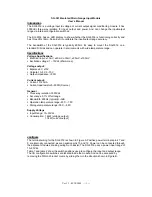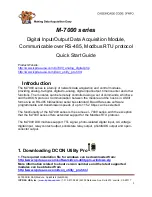
3
*Teflon is a trademark of the DuPont Corp.
Design
Data
ELOC/ROC wrench
(Part #1265)
Installation
The Central Model ROC Residential
Optima™ Concealed Sprinkler must
be installed in conformance with
current NFPA 13, NFPA 13D and
NFPA 13R Standards. Deviations
from these requirements and stan-
dards, or any alteration to the sprin-
kler assembly itself will void any
warranty made by Central Sprinkler
Company. In addition, installation
must also meet local government
provisions, codes and standards, as
applicable.
The system piping must be prop-
erly sized to ensure the minimum
required flow rate at the sprinkler.
Check for the proper model, style,
orifice size and temperature rating
prior to installation. Install sprinklers
after the piping is in place to avoid
mechanical damage; replace any
damaged units. Wet pipe systems
must be protected from freezing.
Upon completion of the installation,
the system must be tested per
recognized standards. In the event of
a thread leak, remove the unit, apply
new pipe joint compound or tape, and
reinstall.
Installation Sequence
Step 1. The unit must be installed in
the pendent position.
Step 2. The face of the sprinkler
fitting should be installed a nominal
2" (
±
1
⁄
4
") behind the finished ceiling
line. Adjustments, to compensate for
variations in fitting face to ceiling
height, may be made by threading the
cover plate retainer in and out of the
unit’s support cup.
Step 3. Use only a non-hardening
pipe joint compound, or Teflon* tape.
Apply only to the male threads.
Step 4. Hand tighten the sprinkler
into the fitting. Avoid making contact
with the deflector when using the
Central Sprinkler Optima™ Con-
cealed Wrench to tighten the unit into
the fitting. The wrench is designed to
mate with the body’s wrench bosses,
inside the threaded support cup. A
leak tight joint requires a only 7 to 14
ft. lbs. of torque. Torque levels
greater than 21 ft. lbs. may distort the
orifice seal, resulting in leakage.
Single Head
Multiple Head
Minimum
Minimum
Minimum
Minimum
Coverage Area
Flow
Pressure
Flow
Pressure
(ft. x ft.)
(gpm)
(psi)
(gpm)
(psi)
20 x 20
(400 sq. ft.)
24
32.7
17
16.4
18 x 18
(324 sq. ft.)
24
32.7
17
16.4
16 x 16
(256 sq. ft.)
18
18.4
13
9.6
14 x 14
(196 sq. ft.)
18
18.4
13
9.6
12 x 12
(144 sq. ft.)
18
18.4
13
9.6
Design Requirements—ROC Residential Optima™ Concealed
Caution: Minimum spacing between sprinklers is 8'.
Step 5. After initial installation and
before the cover plate is installed,
cover the sprinkler with the special
plastic protective cap. The cap is
specially designed to not only protect
the sprinkler, but allow the ceiling
installers to locate the sprinkler by
pressing the ceiling board up against
it. The end of the cap has a special
tip, therefore leaving an impression in
the ceiling board for the location of
the sprinkler. Care should be taken
to only press the ceiling lightly against
the cap as excessive pressure will
damage the sprinkler. This cap must
be removed for the sprinkler to
function correctly.
Step 6. To install the ceiling cover
plate, manually thread the cover
retainer into the support cup. Con-
tinue threading until the cover
retainer’s flange rests against the
surface of the ceiling.
Caution: Special care must be taken
when installing with a CPVC system.
Sprinklers must be installed after the
manufacturer's recommended setting
time for the primer and cement to
ensure that neither accumulate within
the sprinkler.
Special care must be taken when
installing with a copper system.
Sprinklers must be installed only after
the inside of the sprinkler drop and
associated fittings have been wire
brushed to remove any flux. Residual
flux can cause corrosion and in
extreme cases can impair proper
sprinkler operation.
OBSOLETE






















